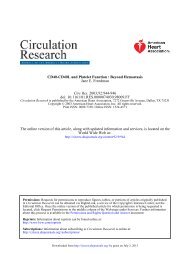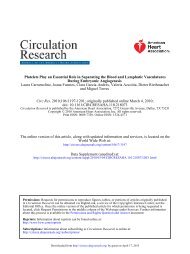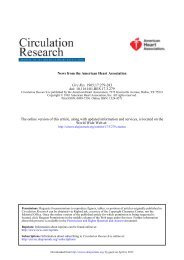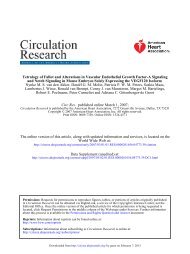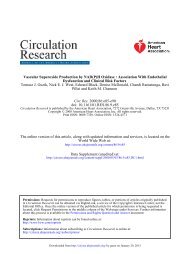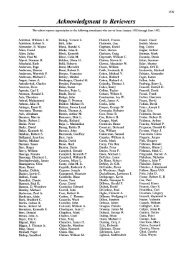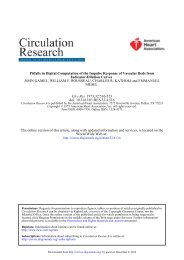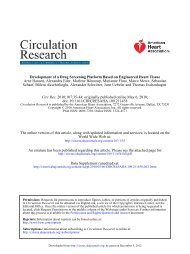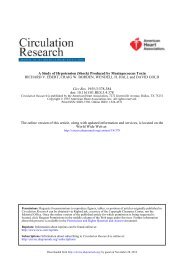Role of Sarcoplasmic Reticulum in Arterial Contraction: Comparison ...
Role of Sarcoplasmic Reticulum in Arterial Contraction: Comparison ...
Role of Sarcoplasmic Reticulum in Arterial Contraction: Comparison ...
Create successful ePaper yourself
Turn your PDF publications into a flip-book with our unique Google optimized e-Paper software.
856 Circulation Research Vol 62, No 4, April 1988<br />
-A<br />
Cat. K<br />
H nU 100 mil<br />
.200 mg<br />
Ryanodhw 10 u<br />
._• V<br />
Cat. K<br />
5 mU 100 mM<br />
FIGURE 1. Effect <strong>of</strong> ryanod<strong>in</strong>e (10 \LM) on contractions<br />
<strong>in</strong>duced by 100 mM K and 5 mM caffe<strong>in</strong>e <strong>in</strong> rat aortic r<strong>in</strong>g.<br />
Tissue was <strong>in</strong>cubated <strong>in</strong> ryanod<strong>in</strong>e for 45 m<strong>in</strong>utes before data<br />
for right-hand side were collected. Each contraction was<br />
preceded by a rest<strong>in</strong>g phase <strong>of</strong> at least 20-30 m<strong>in</strong>utes. Rest<strong>in</strong>g<br />
tension, 500 mg.<br />
Results<br />
Ryanod<strong>in</strong>e Selectively Blocks Calcium Release From<br />
<strong>Arterial</strong> Muscle <strong>Sarcoplasmic</strong> <strong>Reticulum</strong><br />
As illustrated <strong>in</strong> Figure 1, ryanod<strong>in</strong>e completely<br />
blocked caffe<strong>in</strong>e-<strong>in</strong>duced contractions <strong>in</strong> rat aorta but<br />
had only a m<strong>in</strong>imal effect on potassium-<strong>in</strong>duced<br />
contractions. This is consistent with evidence that<br />
ryanod<strong>in</strong>e selectively <strong>in</strong>terferes with SR calcium<br />
release 3 but not gated calcium entry. In contrast,<br />
dantrolene, another agent that is reputed to block SR<br />
calcium release <strong>in</strong> muscle, 26 did not affect caffe<strong>in</strong>e<strong>in</strong>duced<br />
contractions <strong>in</strong> this tissue (Figure 2).<br />
Mechanism <strong>of</strong> Ryanod<strong>in</strong>e Action<br />
Inhibition <strong>of</strong> the caffe<strong>in</strong>e contractions by ryanod<strong>in</strong>e<br />
can be expla<strong>in</strong>ed either by direct blockade <strong>of</strong> calcium<br />
release from the SR or by depletion <strong>of</strong> the SR calcium<br />
store as a result <strong>of</strong> enhanced release and reduced<br />
resequestration. 17 -"' 20 - 27 To dist<strong>in</strong>guish between these<br />
two possibilities, the effects <strong>of</strong> ryanod<strong>in</strong>e were studied<br />
under conditions <strong>in</strong> which calcium extrusion was<br />
<strong>in</strong>hibited. In modified Krebs solution with normal<br />
sodium, ryanod<strong>in</strong>e had no effect on tonic tension.<br />
Supervision with 0-calcium, 1.2-mM-Na solution,<br />
however, will <strong>in</strong>hibit calcium extrusion via Na-Ca<br />
exchange. 2 Under these conditions, ryanod<strong>in</strong>e caused<br />
a slow <strong>in</strong>crease <strong>in</strong> tonic tension that was promptly<br />
reversed when normal external sodium was restored<br />
(Figure 3). This effect was also observed <strong>in</strong> the<br />
presence <strong>of</strong> 1 \JM prazds<strong>in</strong> and 10 JJLM verapamil (not<br />
shown) and therefore was not due either to endog-<br />
Caf<br />
NE NE SmM<br />
30 m<strong>in</strong><br />
200 mg<br />
NE NE NE NE<br />
DantroUne 10 pM<br />
Caf.<br />
S mM<br />
enously released NE or to calcium entry via voltagegated<br />
channels. These data suggest that ryanod<strong>in</strong>e<br />
depleted the SR calcium store by slowly releas<strong>in</strong>g<br />
calcium <strong>in</strong>to the cytosol.<br />
In the absence <strong>of</strong> ryanod<strong>in</strong>e, both caffe<strong>in</strong>e and NE<br />
<strong>in</strong>duced contractions <strong>in</strong> rat aorta superfused with<br />
0-calcium, 1.2-mM-Na solution (not shown; see Itoh<br />
et al 6 for data on rabbit mesenteric artery). Under these<br />
calcium-free, low-sodium conditions, ryanod<strong>in</strong>e reversibry<br />
blocked the contractile responses to NE (not<br />
shown) and caffe<strong>in</strong>e. In the presence <strong>of</strong> ryanod<strong>in</strong>e,<br />
caffe<strong>in</strong>e evoked only relaxation (Figure 3); this is<br />
additional evidence that ryanod<strong>in</strong>e depletes the SR<br />
calcium stores.<br />
Estimation <strong>of</strong> Relative <strong>Role</strong> <strong>of</strong> <strong>Sarcoplasmic</strong> <strong>Reticulum</strong><br />
<strong>in</strong> Vascular Smooth Muscle <strong>Contraction</strong>s<br />
NE contractions <strong>in</strong> rat aorta. <strong>Contraction</strong>s elicited<br />
by NE are, <strong>in</strong> part, dependent on calcium entry from<br />
the extracellular fluid and, <strong>in</strong> part, on calcium release<br />
from the SR. 111 As illustrated <strong>in</strong> Figures 2 and 4-7,10<br />
(JLM ryanod<strong>in</strong>e reduced substantially the NE contractions<br />
<strong>in</strong> rat aorta but did not abolish them. The<br />
dose-response curve (Figure 4) shows that maximal<br />
concentrations <strong>of</strong> ryanod<strong>in</strong>e (10-30 ^M) <strong>in</strong>hibited the<br />
NE-<strong>in</strong>duced contractions by about 45%, suggest<strong>in</strong>g<br />
that about half <strong>of</strong> the contraction elicited by 2-6 x 10~*<br />
M NE could be attributed to calcium release from the<br />
SR. Furthermore, ryanod<strong>in</strong>e (10 ^M) appeared to<br />
<strong>in</strong>hibit contractions elicited by lower concentrations <strong>of</strong><br />
NE to a slightly greater degree than contractions<br />
<strong>in</strong>duced by higher NE doses (Figure 5). This may<br />
<strong>in</strong>dicate that contractions elicited by low concentrations<br />
<strong>of</strong> NE are more dependent on calcium released<br />
from SR than area contractions produced by higher<br />
doses.<br />
When rat aortic r<strong>in</strong>gs were superfused with a steady<br />
concentration <strong>of</strong> NE, tension rose rapidly and then was<br />
ma<strong>in</strong>ta<strong>in</strong>ed (Figure 6). At all NE concentrations,<br />
ryanod<strong>in</strong>e predom<strong>in</strong>antly attenuated the <strong>in</strong>itial rise <strong>in</strong><br />
tension. This is consistent with data from the rabbit ear<br />
artery 21 <strong>in</strong> which only the <strong>in</strong>itial rapid component <strong>of</strong> NE<br />
contractions was blocked by ryanod<strong>in</strong>e; this effect can<br />
be expla<strong>in</strong>ed by depletion <strong>of</strong> the SR store. The tonic<br />
phase, on the other hand, appeared to be slightly<br />
enhanced, possibly due to impairment <strong>of</strong> SR calcium<br />
resequestration by ryanod<strong>in</strong>e.<br />
In contrast to ryanod<strong>in</strong>e, dantrolene had no effect on<br />
the NE-<strong>in</strong>duced contraction (Figure 2).<br />
A A & A A A<br />
NE NE NE NE NE NE NE<br />
Ryanod<strong>in</strong>e 10 pM<br />
FIGURE 2. Effects <strong>of</strong> 10 \xMdantrolene and 10 \iMryanod<strong>in</strong>e on contractile response <strong>of</strong> rat aortic r<strong>in</strong>g to6x 10'' Mnorep<strong>in</strong>ephr<strong>in</strong>e<br />
(NE) and 5 mM caffe<strong>in</strong>e (Caf.). Periods <strong>of</strong> superfusion with dantrolene and ryanod<strong>in</strong>e, respectively, are <strong>in</strong>dicated by bars at top.<br />
Rest<strong>in</strong>g tension, 500 mg.<br />
Downloaded from<br />
http://circres.ahajournals.org/ by guest on April 6, 2013




